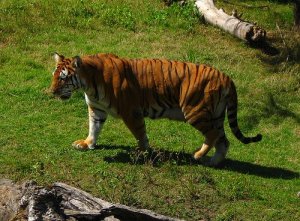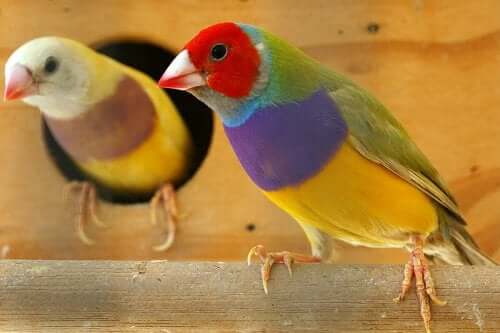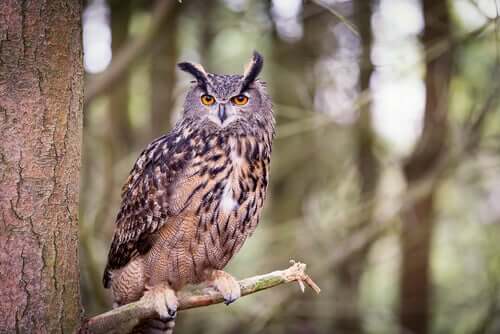Survival Instinct in the Animal Kingdom

They say that in the wild, it’s the strongest who survive. There’s a hierarchy whereby some animals eat others and so on until there’s the one at the top of the pyramid. This is what has led to the development of the survival instinct in the animal kingdom. In this article, we’ll tell you all about it.
The different types of animal survival instinct
The main priority for any animal is to get enough food to survive and, at the same time, avoid being eaten by a predator. In the wild, animals need to be able to run, fly or swim quickly, be good at hiding, and always have one eye open to look out for danger.
But even so, this isn’t easy, and despite having these abilities, survival isn’t guaranteed. Even if an animal survives one predator, you can be sure that another one will appear soon.

The survival instinct is like a switch that goes off in the most adverse situations and activates the animal’s ingenuity to save themselves. Most animals seem to behave in a consistent way as if they were programmed to act the way they do. It’s this behavior that we call the survival instinct.
Just like us, when an animal is afraid, their body reacts and looks for the right moment to flee and the most suitable place to go.
Instinctive behaviors that are part of the survival instinct
Each animal and species has its own instinctive behaviors. These include:
- Incubating. Birds that lay eggs will incubate the eggs of other birds if they find their nest unprotected. It’s not just a way of caring for other birds but of protecting the species as a whole.
- Babies without a mother. There are many examples you may have seen of different species behaving like parent and child. This is an instinctive action to survive on the part of the baby. They’re alone in the world and willing to accept any other animal that makes them feel safe.
- Hiding. When warned of danger or they sense that they’re being watched, many animals hide themselves. They sometimes even do this beforehand, already having a place to flee to in case of danger.
- Eating without looking forward. Being constantly vigilant is one way of surviving in the wild. One slight distraction could cost an animal their life. So, even when feeding, animals are still keeping a lookout.
- Remaining vigilant while awake. The same thing happens when animals are sleeping. Some animals have learned to sleep with the conscious mind but not the subconscious. This means that they don’t go into the deepest phase of sleep and will wake up at the slightest disturbance, hopefully saving their lives in the process.
- Curling up. This ability to curl into a shell or other covering is just one other way that some animals protect themselves from attack.
- Making sounds. Some animals, like the rattlesnake, make sounds to scare their predators. Often, the predator will flee without a fight.

Animal instinct
These animal instincts are what save animals’ lives. Remember who the first ones off the Titanic were? The rats! Even before the water started entering the ship!
Nature and animals are a great source of learning for us, not only to preserve our own lives but to help save other animals and conserve endangered species.
Source of the main image: Sebastián Dario
They say that in the wild, it’s the strongest who survive. There’s a hierarchy whereby some animals eat others and so on until there’s the one at the top of the pyramid. This is what has led to the development of the survival instinct in the animal kingdom. In this article, we’ll tell you all about it.
The different types of animal survival instinct
The main priority for any animal is to get enough food to survive and, at the same time, avoid being eaten by a predator. In the wild, animals need to be able to run, fly or swim quickly, be good at hiding, and always have one eye open to look out for danger.
But even so, this isn’t easy, and despite having these abilities, survival isn’t guaranteed. Even if an animal survives one predator, you can be sure that another one will appear soon.

The survival instinct is like a switch that goes off in the most adverse situations and activates the animal’s ingenuity to save themselves. Most animals seem to behave in a consistent way as if they were programmed to act the way they do. It’s this behavior that we call the survival instinct.
Just like us, when an animal is afraid, their body reacts and looks for the right moment to flee and the most suitable place to go.
Instinctive behaviors that are part of the survival instinct
Each animal and species has its own instinctive behaviors. These include:
- Incubating. Birds that lay eggs will incubate the eggs of other birds if they find their nest unprotected. It’s not just a way of caring for other birds but of protecting the species as a whole.
- Babies without a mother. There are many examples you may have seen of different species behaving like parent and child. This is an instinctive action to survive on the part of the baby. They’re alone in the world and willing to accept any other animal that makes them feel safe.
- Hiding. When warned of danger or they sense that they’re being watched, many animals hide themselves. They sometimes even do this beforehand, already having a place to flee to in case of danger.
- Eating without looking forward. Being constantly vigilant is one way of surviving in the wild. One slight distraction could cost an animal their life. So, even when feeding, animals are still keeping a lookout.
- Remaining vigilant while awake. The same thing happens when animals are sleeping. Some animals have learned to sleep with the conscious mind but not the subconscious. This means that they don’t go into the deepest phase of sleep and will wake up at the slightest disturbance, hopefully saving their lives in the process.
- Curling up. This ability to curl into a shell or other covering is just one other way that some animals protect themselves from attack.
- Making sounds. Some animals, like the rattlesnake, make sounds to scare their predators. Often, the predator will flee without a fight.

Animal instinct
These animal instincts are what save animals’ lives. Remember who the first ones off the Titanic were? The rats! Even before the water started entering the ship!
Nature and animals are a great source of learning for us, not only to preserve our own lives but to help save other animals and conserve endangered species.
Source of the main image: Sebastián Dario
This text is provided for informational purposes only and does not replace consultation with a professional. If in doubt, consult your specialist.








